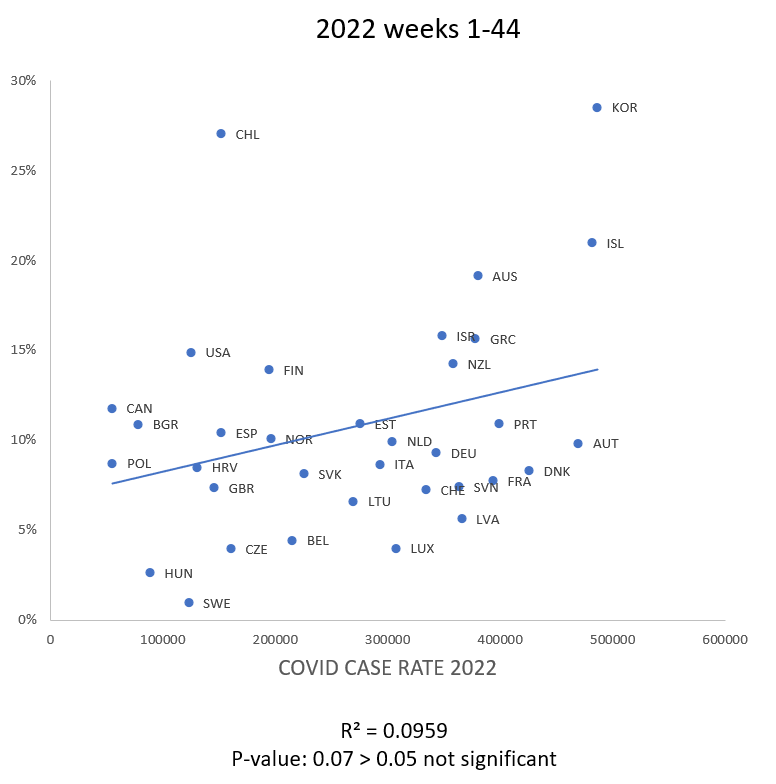What is causing excess deaths: Covid, long-covid, lockdowns, healthcare or the vaccines?
Making fact-checking a habit
Igor Chudov got in contact recently asking us to fact-check his analysis on the world-wide link between vaccinations and excess deaths. His substack gives a thorough description of his results, but basically it wasn’t good news for the covid-19 vaccines and worse news about their effects on mortality:
Igor simply took public data available from our world in data and the human mortality database, ran a straightforward regression analysis and discovered a worrying link between excess mortality and covid-19 vaccination rates. He also did an analysis, by deprivation quartile, using UK data, with very worrying results which confirmed that the least deprived, i.e., wealthier people, were dying at higher rates than the most deprived. This looks odd, because we should expect poorer people to experience worse healthcare outcomes than wealthier people. But given poorer people tend to have lower vaccination rates then deprivation looks to be confounding the underlying causal relationship between vaccination and excess mortality. This then begs the question: If it isn’t wealth that is causing higher mortality, is it the vaccination programme or something else?
(If you want to dig deeper into Igor’s work, he has prepared a handy guide to his numerous posts)
So, we downed tools on other projects and decided to look at the data to see if we could repeat the analysis and also broaden the hypotheses being tested. After all, blaming the vaccines is a pretty big claim to make. We therefore wanted to act as the ‘Devil’s Advocate’ and ask whether there was evidence to support ALTERNATIVE causes of excess deaths, NOT the vaccination programme.
The alternative hypotheses to test are somewhat obvious:
-
Covid-19 occurring in 2022 causing undiagnosed covid deaths in 2022
-
So-called long-covid contracted in 2020/21 causing death in 2022
-
Stringency of lockdown measures in 2020/21 causing additional deaths in 2022
-
Healthcare quality influencing or mitigating excess deaths
And finally, we need to also include….
-
The covid vaccinations administered in late-2020 and 2021 are causing excess deaths in 2022
We decided to explore these hypotheses for weeks 1-44 of 2022, testing simple linear regression models for world-wide data, looking at the whole time period but also splitting it into periods where covid was prevalent, declining and at a minimum (in the summer). We split the year into discrete temporal periods to separate out any covid signal, from other signals, including vaccination, to identify potential causes of excess deaths. The idea being that if a cause is absent or negligible, yet the effect persists, then there must be some other causal explanation at play. So, if there is no covid around then what is killing people? Is it the vaccines? Is it the consequence of lockdown? Or is it long-covid?
All of the data used is from published government sources. Obviously, covid deaths and the reported case rates are doctrinally defined, so the biases are baked into official statistics. Readers familiar with our output know we have more-than-just-qualms about this data, and whether covid is as deadly as claimed. We are therefore giving a HUGE benefit of the doubt to the other side of the argument here. So, any outcome is all the more damning if, acting as the Devil’s Advocate, and using the devil’s twisted definitions, the devil still loses the argument.
PANDA invited us to present this work at one of their regular series of PANDA Open Science meetings. Norman presented first talking about flawed Covid definition, data and modelling, which was released as a post here the other day, and Martin presented this work on excess deaths. The video of the presentation at the top of this post will also appear on PANDA's Rumble channel, but the summary of the results is below.
Note that in this analysis we use data on countries and show them on the charts below using the ISO-3166 country code system.
Our first hypothesis is that covid was killing people but was undiagnosed as a cause of death.
But what we found was that there was no statistically significant relationship between covid-19 cases, in 2022, and the weekly excess mortality experienced from weeks 1-44. So, at this level of analysis, it doesn’t look like covid is driving the excess.
Note: How well the line fits the data is measured by R² and an R² value close to zero is low quality; close to 1 is high quality, in the sense that the line accounts for the variation in the data.
P-values are used to test significance - which we have set at 5%, meaning we accept a 5% probability that the data might be observed by chance even if there was NO relationship.
In the above scatterplot the R² is low, and you can see many points deviate from the line, and insignificant because 7% is higher than the 5% target.
We did find a statistically significant linear correlation between covid rates in 2020 and 2021, which would be causing unresolved, so-called, long-covid in 2022 and which might result in excess deaths occurring this year. However, this relationship was NEGATIVE as is shown below in the scatterplot and linear regression line blow. Hence, the more covid a country had experienced the lower the excess deaths, which is a counter intuitive result under this hypothesis.
This rules out long-covid as an explanation for the excess deaths.
One might expect that the stringency of the lockdowns would affect the excess mortality. However, what we found was that there was no significant statistical correlation between lockdown stringency and excess mortality.
Here we have scatterplots and regression lines for both variables. First for lockdown stringency:
The quality and availability of healthcare would affect excess mortality, and given some countries, like the United Kingdom, essentially rationed healthcare and more-or-less gave up on detecting cancers and heart problems early we might expect to see this affect excess mortality. Unfortunately, we do not have data on quality of healthcare for the period 2020-2022 but have data from 2015. When we use this data, we can see no relationship between the quality of healthcare and excess mortality.
Obviously, in some countries, there will be some interplay between lockdowns and healthcare availability, so there remain some open questions here that require further investigation. If anyone has better data or insights, then please let us know.
OK, so this is the big politically charged high-sensitive potentially career-ending question: If it isn’t something else, then is it the vaccines?
Well, we found a statistically significant linear relationship between countries that are highly vaccinated and excess deaths, as shown below (sure, you could fit a better polynomial model to this but let’s keep it simple).
Things look especially worrying in Chile and South Korea, which you will notice have suffered a lot of covid and are very highly vaccinated. Sweden is again notable for experiencing a much lower excess. But note that ALL countries on this chart have an excess, Sweden’s is just the lowest.
When we aggregate all of the excess mortality for all countries in this analysis (USA, Canda, much of Europe and some southern hemisphere countries: Australia, Chile, New Zealand, and Korea) we can see, in the chart below, that excess mortality more or less tracks the covid trend: when covid rises, excess rises soon after. But this only occurs UNTIL around week 12, when the excess mortality signal separates from the covid signal and as covid declines the excess remains high.
This suggests there is some temporal connection worth looking at
. What is happening after week 12, during the Spring in the northern hemisphere, when covid makes its decline?
To explore whether covid is causing excess deaths at different times of year we can look at whether it correlates with excess deaths. The scatterplots below show the different correlation relationships over discrete overlapping time periods.
The first chart, for covid-19 rates in 2022 and excess deaths, shows that during weeks 1-12 there is no significant correlation - this is because some countries are experiencing low excess deaths despite high covid rates, and some are experiencing high covid rates and high excess deaths (this itself is a bit of a puzzle). These effects essentially cancel out, resulting in near zero correlation.
For weeks 12-24 and 20-32 we do find high, and significant, correlation between excess deaths and covid, suggesting that covid is driving the excess deaths across all countries (even though both excess and covid rates are falling). However, for the final period, weeks 30-44 the effect of covid on the excess deaths has gone, yet excess mortality remains positive across the board.
Next, we did the same temporal analysis for the vaccination programme and excess mortality and asked: in the relative absence of covid, is the excess mortality related to vaccination rates, and is this correlation persistent over time?
There is no significant correlation between the vaccination rates and excess deaths in weeks 1-12 (although covid deaths in those vaccinated might be masking any effect). But from week 12 to week 44 we can see that there is a statistically significant linear correlation between vaccination rates and excess mortality, with significant and high R² values. Given that covid is reducing and near absent near the end of this period this suggests a strong causal effect of the vaccines. And the fact that it is maintained whilst covid is at a minimum by week 44 is a clear signal. This looks worrying.
Before concluding anything there are some caveats to the analysis we should mention:
-
The way we split into time periods is quite coarse and there are better ways to do this.
-
GIGO – this analysis is only as good as the data and definitions and there are known biases here.
-
Reporting delays and lags are a potentially big issue.
-
The USA is a big country with many states having very different covid policies. Luxembourg is a small country. They are treated equally in this analysis. It’s exploratory.
What can we conclude then from our EXPLORATORY analysis:
-
Clearly the surge in Covid-19 and its effect on excess deaths shows the vaccines are not effective. This looks self-evident and this isn’t news.
-
There is no evidence to support long-covid as a cause of excess deaths.
-
There is weak evidence of the negative effect of lockdown measures (see the video).
-
Healthcare quality looks to be irrelevant, but we are not satisfied we have good metrics for this.
-
There is a clear signal that the vaccination programme is causing, at least, some of the excess death rate. With this data the vaccines don’t look to be safe.
How long this run of excess deaths lasts is an unknown and remains a frightening prospect. Whether the effects of the vaccination programme persist we do not know, but the evidence for a plausible biological mechanism connecting the vaccines and sudden deaths is now widely accepted.
You should watch the video for the full presentation, but please bear in mind that this is Science in Actionᵀᴹ and nowhere near the final word on the issue. It is EXPLORATORY, in the same way that in ‘olden days of yore’ scientists and statisticians would have been all too eager to answer difficult questions requiring honest evaluation of all available evidence (it might even have been career enhancing to do so).











